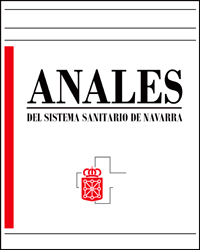Aetiology and antibiotic sensitivity of the most frequent outpatient infections, except those of the lower respiratory tract
DOI:
https://doi.org/10.23938/ASSN.0803Keywords:
Tratamiento empírico. Antibióticos. Sensibilidad a antimicrobianos. Atención primaria.Abstract
Reporting of antimicrobial susceptibility profiles is recommended in order to improve antibiotic prescribing policies and to avoid the emergence of bacterial resistance. During 2001, susceptibility data from bacterial isolates collected from urine, faeces and ear swabs and antimicrobial susceptibility for Streptococcus pyogenes during the first five months in 2002 were recorded in the Health Area of Pamplona (389,489 inhabitants) and compared against data for antibiotic prescriptions. More than 80% of bacteria from urine were susceptible to amoxicillin plus clavulanic acid, oral cephalosporins, fosfomycin and nitrofurantoin. Of the Salmonella Enteritidis isolates, 98.3% were susceptible to trimethroprim-sulfamethoxazole and 96.6% of Campylobacter jejuni to erythromycin. Amoxicillin remained susceptible for more than 95.5% of middle ear isolates. Gram-negative bacilli isolates from otitis externa swabs were susceptible to ciprofloxacin, gentamicin and polimyxin B in over 80% of cases. Of the Streptococcus pyogenes isolated, 22.5% were resistant to erythromycin. Antimicrobial comsumption in defined daily doses per 1,000 inhabitants, day (DID) during 2001 was 14.8. Here, we highlight the over-prescription of some broad-spectrum antibiotics and macrolides for the empiric treatment of infectious diseases in our area. Knowledge of local susceptibility patterns is essential in order to inform empiric therapy.Downloads
Downloads
Published
How to Cite
Issue
Section
License
La revista Anales del Sistema Sanitario de Navarra es publicada por el Departamento de Salud del Gobierno de Navarra (España), quien conserva los derechos patrimoniales (copyright ) sobre el artículo publicado y favorece y permite la difusión del mismo bajo licencia Creative Commons Reconocimiento-CompartirIgual 4.0 Internacional (CC BY-SA 4.0). Esta licencia permite copiar, usar, difundir, transmitir y exponer públicamente el artículo, siempre que siempre que se cite la autoría y la publicación inicial en Anales del Sistema Sanitario de Navarra, y se distinga la existencia de esta licencia de uso.








